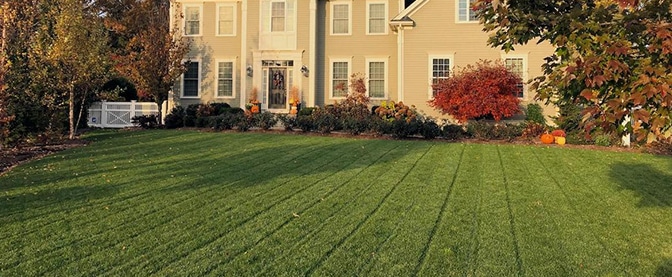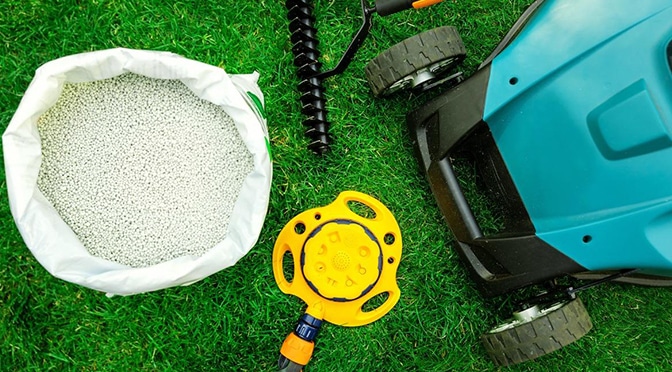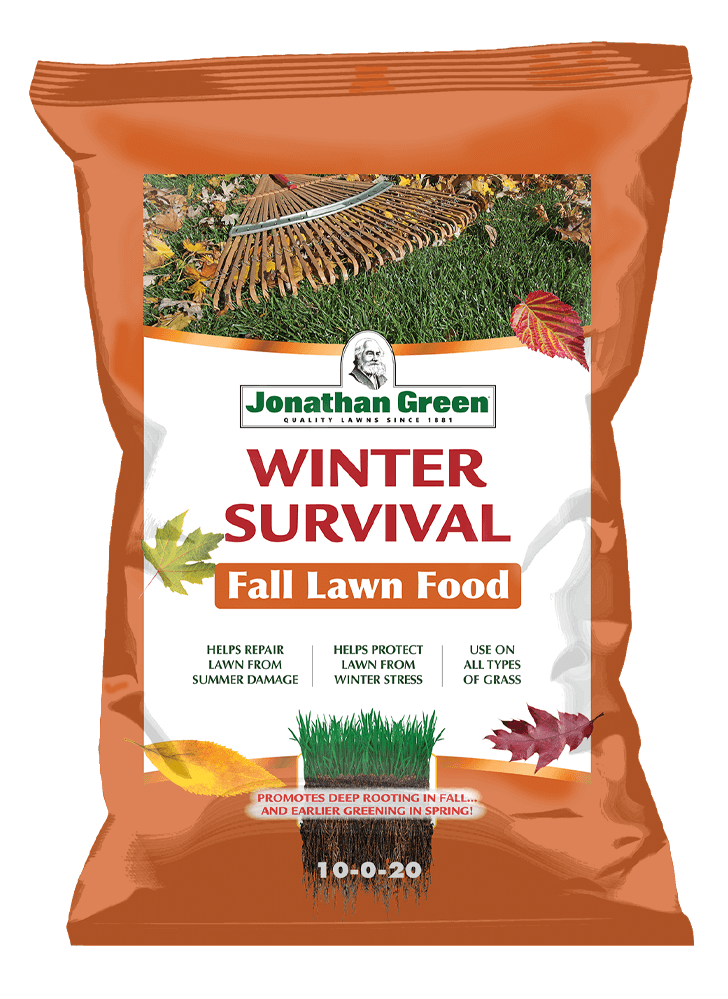Fall Lawn Fertilizer: Boost Your Lawn’s Health for Winter
Fall is the ideal season to feed cool-season lawns to give them the nutrients they need to recover from summer stress and prepare them for the harsh winter conditions ahead. The cool air temperatures of fall provide your lawn a period of recovery from summer heat while- the soil temperatures are still warm enough for grass roots to grow deep.

A fall fertilizer application will not only help to protect your lawn from winter damage, but it’s nutrients will also help to green up your lawn in the early spring.
Benefits of Fertilizing in the Fall
Repair Summer Damage
A fall fertilizer application will help repair any wear and tear that occurred during the summer. The combination of high temperatures, drought, and heavy traffic can take a toll on your grass. By giving your lawn a nitrogen-boost in the fall, it will help to strengthen any weak or brown spots and stimulate growth.
Protect Your Lawn From Winter Weather
Winter weather can harm your lawn if it doesn’t have the reserves it needs to ward off disease and stress. By applying fertilizer it gives your lawn the chance to build stamina before going dormant in the winter. By doing the work in the fall, you can set your lawn up with a good defense system to help it resist winter stress and disease, such as snow mold.
Early Spring Greening
Applying fertilizer in the fall is a great way to give your lawn a boost of nutrients to help green-up grass in the spring. Your lawn will need a pick-me-up after being dormant during the winter months. By applying fertilizer in the fall, it will help to build up deeper roots overtime that ultimately help to grow a thicker, greener lawn for spring.
Deep Rooting
The nutrients in fertilizer will help to build a stronger, deeper root system for improved winter hardiness, which is necessary for the period of dormancy when grass growth slows. Choose a fertilizer that is high in potassium, a necessary element that will help encourage deep root growth, boost the root system’s ability to ward off disease and withstand winter stress.
Choose the Right Fall Lawn Fertilizer
In order to grow healthy and strong turf that can withstand seasonal stressors, you need to feed your lawn with a fertilizer that will give it the right combination of these key elements: nitrogen, phosphorus and potassium.
In the fall, it’s important to choose a fertilizer that is high in nitrogen, which is an essential element that aids in plant growth. By choosing a fertilizer with a slow-release nitrogen formula for fall, you will be able to give your lawn a boost while avoiding overgrowth, which can encourage snow mold.
The potassium will promote deeper rooting, and act as a vitamin for your lawn, increasing its hardiness and immunity to resist winter stress. Phosphorus also helps with deep rooting, but is usually not recommended for use outside of new seeding or sodding due to many lawns already having an excess of it in the soil and the potential negative environmental effects.
Jonathan Green Winter Survival Fall Lawn Fertilizer is an ideal fall fertilizer that is formulated with the key elements needed in autumn: slow-release nitrogen and potassium (10-0-20). It encourages stronger, deeper roots, repairs summer wear and tear, and helps to prevent disease in the winter.

When to Apply Fertilizer in the Fall
Time is of the essence when it comes to applying fall fertilizer to your lawn. Cool season grasses like to be fertilized twice in the fall – once in early fall (late August to September) and again in late fall (late October to November) before the ground freezes and when grass growth has started to slow down considerably. Make sure to tailor this schedule to your specific region and climate conditions.
It’s also important to note when not to apply fertilizer to your lawn in the fall. Pay close attention to blackout dates (periods of time when fertilizer cannot be applied legally in each state) for your area and tailor feeding plans accordingly. Applying fertilizer too close to snow or rainfall can cause harmful runoff to nearby water sources.
Furthermore, applying fertilizer at the wrong time runs the risk of causing damage to your lawn that will be harder to fix if left to fester over the winter dormancy period. You should never apply fertilizer to a lawn that has frost or snow on it, as this will encourage snow mold.
Tips for Applying Fall Lawn Fertilizer
Remove Leaves and Debris
Prior to application, make sure your lawn is free of any debris and leaves. This will ensure a clear surface so the fertilizer can reach in between grass blades. Leaving fall leaves or debris on your lawn for too long can also negatively impact the overall health of your grass, as it can encourage snow mold in the winter or create bare spots.
Follow Label Instructions Carefully
Make sure you read through all of the directions on the fertilizer bag before you begin applying to the lawn. This will help to avoid possible damage from applying too much, too little, or applying at the wrong time.
Use a Spreader
Use a spreader to make sure every part of your lawn gets an even amount of fertilizer. Use a rotary spreader for larger lawns, and a drop or hand spreader for smaller lawns. Make sure you have your spreader on the right setting and that the opening at the bottom of the hopper is closed before filling the spreader with fertilizer. Always remember to walk at a slow and steady pace for an even application.
Sweep Excess Fertilizer
To avoid staining hard surfaces such as sidewalks, driveways, and curbs, sweep any excess fertilizer granules back onto the lawn. This will also help to prevent runoff into storm water systems and groundwater supplies that can have harmful environmental effects.
Conclusion
There’s no way around it – feeding your lawn is important. It is a vital element in every successful lawn care routine. Feeding your lawn in the fall sets your lawn up for success as it repairs and restores it back to health from summer damage, strengthens its immunity to disease in the winter, and invites you in with a lush, green color once spring arrives. If you want your lawn to thrive, make sure to fertilize with Jonathan Green Winter Survival this fall!
